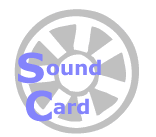|

Sound Card - Making The Noise
-Well now we need to know what formats are supported on a sound card. Its hard to figure out what everyone's sound card supports and doesn't support, but there are formats that are pretty universal. Some of these formats are MIDI, WAV, Wavtable, Direct Sound, and AC-3 to name a few. I will cover these for they are most likely what you have at home. There are a couple more formats out there that have been abandoned due to horrible sound. Lets look at the ones that stuck.
-Wave Audio, this is the most common type of Audio available on the sound card. Again we take analog information and use analog to digital converters to make it represent 0's and 1's for the computer. The quality of WAV files are great except that they are usually to BIG! Kind of a bummer really, but you have to pay for quality. In other formats the files size isn't so scary as is the WAV file. The file size can also depend on what the quality of the file was saved in. You can save some as CD-quality, Radio-Quality, and Telephone-quality in windows. Now of course the CD quality is the best and in 16 bit format may take up valuable space. Other than the CD you can save files as Radio and Telephone. This really reduces quality and store it in a 8 bit format.
-Midi, this is a kind of neat compared to WAV and is still very popular. The MIDI (Musical Instrument Digital Interface) is still popular due to it size and quality. A MIDI file can be considerably less than the WAV. The drawback to this type file is that the MIDI is just recorded electronic sounds unlike WAV which is taken from say , your voice or outside source. But for those that may like a electronic rendition of Bach will be in good shape with MIDI. Most sound card or there software have a library of MIDI instruments and can interpret them and play them. The MIDI as said before is only good for musical scores and not for analog inputs like the human voice. There are two type of MIDIs that we should also cover this more or less gets into 8 bit audio and 16 bit audio. Never buy less than a 16 bit sound card by the way. Two forms of MIDI are FM and Wavetable MIDI.
-FM MIDI, this wasn't to long ago when affordable sound cards only incorporated the FM MIDI. To make a long story shot the FM MIDI didn't have much to offer and didn't sound to great. Most enriched MIDI files sounded fairly bad on a card that had only FM MIDI on it. This is still around I am sure and you will find on a 10.00 8 bit Sound card.
-WaveTable MIDI, this is found on newer cards and can get somewhat extravagant. Even holding 8 MB of memory just to hold all the MIDI devices. The wavetable makes the electronic sounds of the MIDI and its instruments sound great! The Wavetable MIDI usually supports polyphony sound. This amounts to how many instruments can play at one time. Pretty neat to hear as many as 64 instruments playing at one time.
 Installing a Sound Card Installing a Sound Card
 Back To Hardware Guides Back To Hardware Guides
Popular Articles:
How To Build A PC | Different Types of Keyboards | Help with Hard Drive Installation | Computer Networking Basics | Introduction of Motherboard Functions | Computer CPU Processor Speed | Upgrade from Windows 95 to Windows 98 | Computer Monitor Troubleshoot | Partition Hard Drive | Installing New CPU Processor | Types of Network Cables |